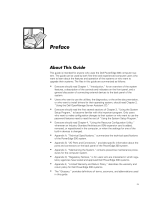
Introduction: Dell PowerVault™ 50F 8-Port Fibre Channel Switch User's Guide
file:///C|/Users/sharon_anand/Desktop/PowerVault/50f_enug/INTROD.HTM[3/15/2013 11:27:27 AM]
Simple — Easy setup and configuration. After power-on self-test (POST), you needed only to add the
switch's Internet Protocol (IP) address. The remainder of the switch's setup is automated.
Intelligent — The switch's firmware allows discovery of all connected devices and determines optimum
data paths without intervention, supporting up to 32 interconnected switches.
Flexible — Modular design with multiple interface cards, supporting G_Port (F_Port and E_Port),
FL_Port cards, gigabit interface connector (GBIC) modules supporting both, and copper and optical
media. The switch's modular construction gives the switch a range of flexibility in creating, upgrading,
maintaining, and configuring a Fabric.
Reliable — Highly integrated, reliable, multifunction application specific integrated circuit (ASIC)
devices are used throughout the switch.
High performance — Low-latency, high-performance design requires no microprocessor data path
interaction, resulting in a worst-case, data transfer latency of less than 2 microseconds. The latency
may differ when the destination is a loop.
Automated congestion management — Virtual channels lets the switch use sophisticated congestion
management techniques that are performed automatically by the switch.
Table 1-1 describes additional PowerVault™ 50F Switch technical features:
Table 1-1. PowerVault™ 50F Switch Technical Features
Feature Description
Login (FC) Explicit Fabric login is supported (public and private).
Probing Automatic discovery of devices and auto registration with the Fabric Simple Name Service (SNS). For private
devices, translation mode is set so that other Fabric-attached devices can communicate with them.
Virtual channels The switch has eight virtual channels and four priority levels supporting each switch port. Different virtual
channels are automatically assigned with different priority levels to accommodate various types of data flow,
different communications protocols, and user applications. Virtual channels provide a flexible congestion
management that is also used to separate traffic among:
Fibre Channel Link Control frames and Data frames
Class 2, Class 3, and Class F frames
E_Port, F_Port, and FL_Port destined traffic
Data Field Size The Fibre Channel frame's data field size is up to 2112 bytes.
Buffer-to-buffer
credit
Buffer-to-buffer credit for each F_Port can be up to 16 credits. For the E_Port, buffer-to-buffer credit can be a
total of 62 credits distributed among all eight virtual channels.
The FL_Port uses the alternate buffer-to-buffer credit management model. Each FL_Port may be configured to
Open and supports a BB_Credit of 0 or 1. Up to 16 credits can be made available when opened. Open transmit
credit can be 0 or 1 on a per-destination NL_Port basis.
Time Out
Values
Both Resource Allocation Time Out Value (R_A_TOV) and Error Detect Time Out Value (E_D_TOV) are
adjustable in 1-millisecond increments via Telnet.
Fabric Name An automatic Fabric Name assignment method is used in a multiswitch configuration.
Frame Delivery The switch delivers the frames via the destination F_Port in the same order received by the source F_Port. The
in-order frame delivery is maintained within a Fabric of multiple interconnected switches.
Address
Assignment
The switch follows the addressing hierarchy defined in the Fibre Channel Standard. The switch port address
identifiers are selected using an automatic address assignment protocol. All ports within the switching Fabric
(F_Ports, FL_Ports, and E_Ports) are assigned address identifiers. Each switch maintains its own address pool.
The management of address identifiers and assignment of the address pool to the individual switches are
performed by the designated address managers within the Fabric.
Broadcast and The system supports up to 32 multicast groups, one is reserved for broadcast. Any port can be a member of




















